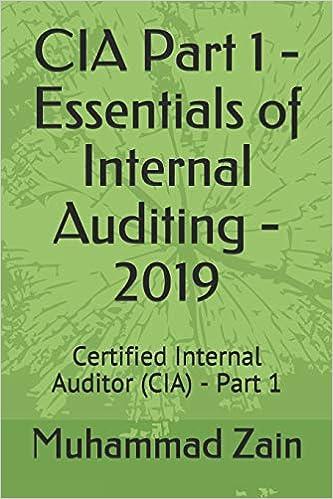

 c. Complete the consolidating entries according to the C-E-A-D-I sequence and complete the consolidation worksheet.
c. Complete the consolidating entries according to the C-E-A-D-I sequence and complete the consolidation worksheet.
10 years Prepare consolidation spreadsheet for continuous sale of inventory-Cost method A parent company acquired 100 percent of the stock of a subsidiary company on January 1, 2013, for $800,000. On this date, the balances of the subsidiary's stockholders' equity accounts were Common Stock, $50,000, Additional Paid-in Capital, $55,000, and Retained Earnings, $195,000. On the acquisition date, the excess was assigned to the following AAP assets: Original Amount Original Useful Life Property, plant & equipment 280,000 Customer list 180,000 8 years Royalty agreement 160,000 8 years Goodwill 120,000 Indefinite The Goodwill asset has been tested annually for impairment, and has not been found to be impaired. Assume that the parent company sells inventory to its wholly owned subsidiary. The subsidiary, ultimately, sells the inventory to customers outside of the consolidated group. You have compiled the following data for the years ending 2015 and 2016: Inventory Gross Profit Remaining in Receivable Sales Unsold Inventory (Payable) 2016 $38,000 $6,000 $26,000 2015 $58,000 $8,500 $13,000 The inventory not remaining at the end of a given year is sold to unaffiliated entities outside of the consolidated group during the next year. The parent uses the cost method of pre-consolidation Equity Investment bookkeeping. The financial statements of the parent and its subsidiary for the year ended December 31, 2016, follow: Parent Subsidiary Parent Subsidiary Income statement Balance sheet Sales $4,350,000 $800,000 Assets Cost of goods sold (3,050,000) (480,000) Cash $650,000 $330,000 Gross profit 1,300,000 320,000 Accounts receivable 560,000 180,000 Income (loss) from subsidiary 15,000 Inventory 850,000 250,000 Operating expenses (830,000) (200,000) Equity investment 1,040,000 Net income $485,000 $120,000 Property, plant & equipment 4,000,000 420,000 Statement of retained earnings $7,100,000 $1,180,000 BOY retained earnings $2,000,000 $485,000 Liabilities and stockholders' equity Net income 485,000 120,000 Accounts payable $350,000 $100,000 Dividends (125,000) (15,000) Other current liabilities 400,000 125,000 Ending retained earnings $2,360,000 $590,000 Long-term liabilities 2,500,000 260,000 Common stock 700,000 50,000 APIC 790,000 55,000 Retained earnings 2,360,000 590,000 $7,100,000 $1,180,000 Description Debit Credit [AD]] 0 0 0 [C] 0 0 0 0 [E] 0 0 BOY Common stock (Subsidiary) BOY APIC (Subsidiary) 0 0 0 0 0 0 [A] 0 0 PPE, net Customer list Royalty Agreement 0 0 0 0 0 0 0 0 [D] 0 0 0 0 0 0 Customer List Royalty Agreement 0 0 0 [lcogs] 0 0 0 To recognize prior year profit on intercompany sales. [Isales] 0 0 0 0 [lcogs 0 0 0 0 To defer current period profit on intercompany sales. [lpay] 0 0 0 0


 c. Complete the consolidating entries according to the C-E-A-D-I sequence and complete the consolidation worksheet.
c. Complete the consolidating entries according to the C-E-A-D-I sequence and complete the consolidation worksheet.





